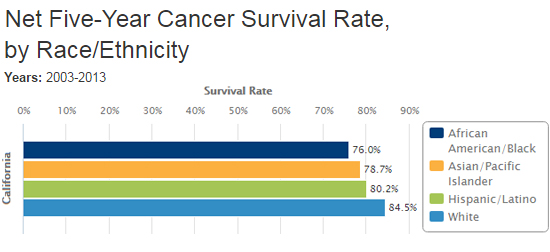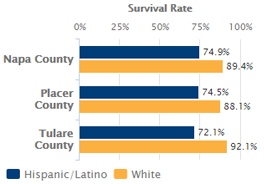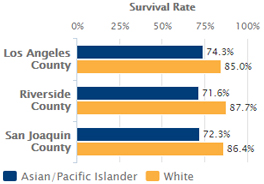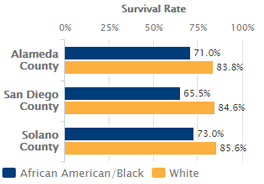Racial, ethnic gaps in kids’ cancer survival rates persist in California
PALO ALTO, California — Gaps persist in California’s net five-year survival rates among children and youth ages 0-19 diagnosed with cancer between 2003 and 2013.
The survival rate among white children is 85 percent, compared with 80 percent for Hispanic/Latino children, 79 percent for Asian/Pacific Islander youth, and 76 percent for African American/black children.
Data at the county level are limited; however, variation in gaps across counties is wide. A few counties, such as Sacramento and Contra Costa, show less than a five percentage point gap in cancer survival rates across racial/ethnic groups, but most counties show wider gaps.
The figures below show a selection of counties with data that had a gap wider than 10 percentage points for three racial/ethnic groups in California.
The gap in cancer survival rates between white and Hispanic/Latino children is four percentage points at the state level. Counties with gaps greater than 10 percentage points include Napa, Placer, and Tulare.
The gap in cancer survival rates between white and Asian/Pacific Islander children is six percentage points at the state level. Counties with gaps greater than 10 percentage points include Riverside, San Joaquin, and Los Angeles.
Policy implications
Early identification of affected children and ready access to pediatric specialty centers for diagnosis and ongoing care are key to cancer survival. Public policy ensuring that all children with cancer have adequate health insurance is essential to providing them with access to equitable, appropriate, and affordable care, experts say.
The Affordable Care Act (ACA) addresses cancer and other chronic illnesses by requiring regular, comprehensive preventive care without copayments and by eliminating lifetime caps on care and denials of coverage based on pre-existing conditions.
Additional policies could assure that all pediatric cancer patients, regardless of race/ethnicity or family income, have consistent access to affordable health care that is evidence-based, well-coordinated, family-centered, and provided in the context of a medical home. Access to care coordination services is especially important as these children and their families need to navigate and align an array of services





